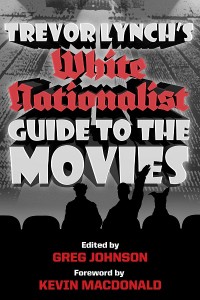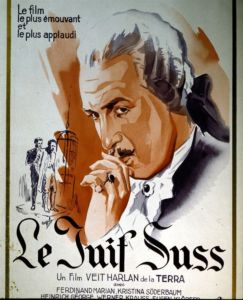1,473 words
Part 2 of 2 (Part 1 here)
Harlan’s film, unlike Mendes’, was an enormous box office success,[1] and it is said that concentration camp guards and the SS were shown this film to remind them of their duties. It is fast-paced, and Harlan shows things: the oppression of Süß’s decrees, Theodora’s corpse, the angry mob, and the people fighting for their rights. Sturm’s calm, civil demeanor is contrasted with Süß’s slick manipulation and George’s overbearing yet sensual Karl. It reminds us that National Socialism was ostensibly a working-class revolution. Hitler wanted little to do with the aristocracy, and had nothing but contempt for Kaiser Wilhelm. And it is interesting to note that in both Süß films, Jewish rights and democracy are shown to be contradictory. If the Jew is to rule wisely through acting for his Duke, then the people’s concerns must be suppressed.
Merian as Süß offers a strong and nuanced performance. Süß isn’t depicted as an evil, hand-rubbing Jew cackling at plots to destroy the goyim. Instead, he is more childlike, grabbing more and more power, and is unable to stop: making one demand, then the next, and then another . . . Süß is charming and witty, but also reckless. He gambles a lot, and in the end, when everything is falling apart, he doesn’t flee, but stays at the gaming table.
I don’t see his rape of Dorothea as the act of an evil Jew who is lusting after goyische women. He is simply imitating the Duke, and takes his desires and power to coerce to its fullest extent. Like Frankenstein and the child, he didn’t purposefully kill her. And in both films, the story begins with a man seeking retribution and switches to the people restoring order. Although it should be noted that Frankenstein, while a monster, is a creation of science, and therefore isn’t to blame for his actions.
In Mary Shelley’s Frankenstein novel, Frankenstein is the name of the scientist, and he is articulate. Just as the Jews were, his monster is banished and feared by the people. The monster also kills a child unintentionally, but when he murders Elizabeth, Dr. Frankenstein’s bride, it is out of a warped despite for revenge, given that Dr. Frankenstein failed to create a wife for him. The “monster” offers a rationale for his actions; it is the argument of a creature without a conscience, but he debates his creator nonetheless, and there is a cold logic to his justifications.
Süß doesn’t argue from the standpoint of revenge, but says that the things he does are for the greater good and for a better world. I think he even believes it to some extent. It is similarly true that without the Duke’s avarice, Süß would have gotten nowhere — much as the monster tells Dr. Frankenstein that he is responsible for what he does, as his creator.
Another film that bears a resemblance to Jud Süß is Allegheny Uprising, a 1940 John Wayne film I have reviewed, where American settlers revolt against British authority after being partly instigated by crooked Philadelphia merchants. The major difference between this film and Jud Süß is that, of course, Jews weren’t a problem in colonial times.
Mendes’ pro-Jewish propaganda is far more open than Harlan’s anti-Semitism. Jud Süß is usually seen as a bit of Nazi Jew-hatred. The Warfare History Network’s blurbs are typical: “Fueled the Holocaust . . . Despicable Propaganda Film.” But it can be seen as equal time from the other side to balance Mendes’ film. It offers a historical view of the relations between Jews and gentiles that we aren’t used to seeing in our age of devotion to equality — and moreover, any narratives that question absolute Jewish innocence and nobility are invariably censored.
Historical context is essential in all discussions of the Third Reich. Our establishment prefers to take the line that Jews have always been mere victims of hate and prejudice. But E. Michael Jones, in The Revolutionary Jew and His Impact on World History, recalls Jewish influence in Poland, where the aristocracy in effect turned over economic power to the Jews, who included selling liquor, leasing rights on land, and other controls on commerce which extended to the point that a church couldn’t even hold weddings or funerals unless they paid a fee to the Jew who owned the land. Moreover, controlling liquor licenses meant they manipulated the price of grain. It is no wonder that Jews flocked to Poland, and that in the seventeenth and eighteenth centuries it was the center of world Jewry. The Polish aristocrats still ostensibly ruled, lost control to the point that by the 1790s, it disappeared as a result of being partitioned by its neighbors.

You can buy Trevor Lynch’s White Nationalist Guide to the Movies here
Hitler’s obsession with the Jews centered on the Ostjuden, the eastern Jews. Aside from his racial and cultural distaste, he saw what Jewish economic control had done to the Slavic world, and wanted to stop that from happening in Germany. Jud Süß, which in Feuchtwanger’s version is a sympathetic tale, becomes a cautionary one in Harlan’s hands.
There is a similar warning about the Jews in Erich Waschneck’s 1940 film Der Rothschilds, which chronicles the Jewish banking house’s domination of the financial markets. There is a notable scene where the Rothschild brothers draw a map of their banking influence over Europe, connecting all the cities with a Star of David.
But was this merely propaganda? One could hardly dispute the Rothschilds’ economic power. They acquired a lock on first European, and then world banking, because true economic power comes from a chain of lending institutions rather than one center. And in Poland, Jewish control brought increasing resentment from ordinary people. When the Jews extended their control into the recently-acquired Cossack lands, the Cossacks revolted. We often hear Jews complain about the mean, hateful Cossacks, but the fact is that this was largely the result of Jewish efforts to bleed their lands dry.
In his book Defensive Racism, Edgar Steele writes:
Yes, Jews do get persecuted. What gets overlooked is the reason. Kind of like focusing on the rights of the murderer and not his victim. No, not “kind of.” That’s exactly what it is. “Oy! Foist Egypt, den Goimany, now here. Why are dey poisecuting us so? Trust me, they know precisely why.
I quote Steele because he, an attorney, was arrested by the FBI on trumped-up charges of attempting to murder his wife and mother-in-law — after he had just had bypass surgery. He was imprisoned and eventually died in jail — not because he was a Nazi, but because he defended Nazis in court. He was denied his heart medication, which contributed to his death – and obviously so he could be made an example.
Similarly, after the war anyone connected with Jud Süß was arrested by the Allies and forced to go through their “denazification” process. In 2010 a documentary, Jud Süß: Rise and Fall, was released in Germany, directed by Oskar Roehler, and is about the making of the film. It particularly focuses on Ferdinand Marian. The film garnered several prizes and was considered “controversial” (since it wasn’t rabidly anti-Nazi), depicting Marian as a man who was haunted after the war for having taken the part — although he died in a car accident in August 1946. Some say it was a suicide, but there is no evidence of this.
Jud Süß remains relevant — not as a relic of vicious anti-Semitism, but a thoughtful perspective on Jewish power when it teams up with a plutocracy and corrupt politicians against public interests. Consider the fact that anyone aspiring to high office in the United States today is required to don the yarmulke and pay his obeisances at the Wailing Wall in Jerusalem.
It’s also clear what the combination of Jewish activism and federal power have wrought in post-war America. The scene in Jud Süß where Jews are brought into Württemberg under military protection recalls the scenes of racial integration at Little Rock and elsewhere, where blacks were brought into schools under the cover of bayonet-wielding troops. The scenes of this in Jud Süß thus seem creepy today. Jud Süß isn’t hate; it’s prophecy.
In fact, viewers today should overlook the film’s “anti-Semitism” and “pro-Nazi” messages and ask if Süß’s manipulation of his society is any different than what we today when the Jewish-corporate hierarchy buys off or blackmail our (presumably) honestly-elected Solons. Given the political changes that we have seen since 9/11, Obamanation, and COVID is that the establishment’s consensus is wrong, if not manipulative, and it is time to look for new interpretations and meanings in our fracturing empire.
Please watch these films — either one, or all three — and come to your own conclusions. As we used to say in college, compare and contrast. That’s all.
* * *
Like all journals of dissident ideas, Counter-Currents depends on the support of readers like you. Help us compete with the censors of the Left and the violent accelerationists of the Right with a donation today. (The easiest way to help is with an e-check donation. All you need is your checkbook.)
For other ways to donate, click here.
Note
[1] For the record, Videohound Golden Movie Retriever reviewed both films; Jew Süß gets two and a half bones, and Jud Süß gets three.
Enjoyed this article?
Be the first to leave a tip in the jar!
Related
-
The Fall of Minneapolis
-
Notes on Plato’s Gorgias, Part 13
-
Adolph Schalk’s The Germans, Part 2
-
Adolph Schalk’s The Germans, Part 1
-
Nowa Prawica przeciw Starej Prawicy, Rozdział 15: Ten dawny liberalizm
-
The Search for the Holy Grail in Modern Germany: An Interview with Clarissa Schnabel
-
Notes on Plato’s Gorgias, Part 12
-
Notes on Plato’s Gorgias, Part 11

3 comments
When I first saw the title of this article, I misread it as “Sussudio” and thought it was going to be about the Phil Collins song. My apologies for not contributing something more substantive to the comments.
My mind wandered to Theodor Seuss Geisel and his early masterpiece Thidwick the Big-Hearted Moose – a carefully crafted allegory of hospitality abused, forebearance in the face of mass immigration, near death and finally a cathartic migration across the water to be with one’s own kind. It’s a must read if an unexpurgated copy can be obtained.
He was pretty based, but he liked his Lefty atmosphere at PM, because they weren’t steering him this way or that. So he did ‘racist’ anti-Jap cartoons…so what?
When the post-OSS Ted moved to the exclusive La Jolla community of Mt Soledad, he was supposedly steered there by a Jewish realtor operating under the name of Finley. (Why do they always choose Irish names?)
Anyway, La Jolla infected Ted Geisel’s drawing for the rest of his life. He looked out his window and saw steep hillside with eucalyptus trees. Go on, check out his books from the 50s and 60s.
https://www.dirt.com/gallery/more-dirt/artists/theodor-dr-seuss-geisel-house-la-jolla-california-1203577270/#recipient_hashed=394967ed643f409b61257018f42c87289aa9999bec497d7e86e8e6d403e3784a&utm_medium=email&utm_source=exacttarget&utm_campaign=dirt_dirtysecrets&utm_content=374629_08-25-2022&utm_term=268068
Comments are closed.
If you have Paywall access,
simply login first to see your comment auto-approved.
Note on comments privacy & moderation
Your email is never published nor shared.
Comments are moderated. If you don't see your comment, please be patient. If approved, it will appear here soon. Do not post your comment a second time.